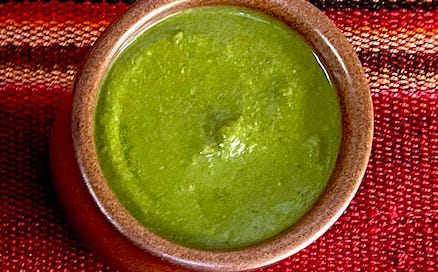As a Peruvian chef in the Pacific Northwest, I visit farmers markets and source local ingredients to reinterpret the creole and Andean dishes I grew up with. One versatile sauce with complex flavors, yet simple to prepare, is uchucuta—a herbaceous green salsa with hot peppers.
My parents tell me that my abuelitas used a batán to crush ingredients for sauces. That’s how they prepared huancaina, a creamy sauce with aji amarillo hot peppers that they poured over boiled potato rounds.
In the Peruvian Andes, another popular sauce is uchucuta. In Quechua, uchucuta means “crushed hot peppers,” and it’s the spicy paste that Indigenous people have made for thousands of years using a batán.
A batán consists of two large stones: one semicircular, the other flat or slightly concave. To make a simple uchucuta, cooks place sliced hot peppers on the flat stone, and crush them by rocking the semicircular stone over the peppers. Then they add more ingredients, like huacatay, a mint-like wild plant from the Andes, and mash them into the paste.
Huacatay, used extensively in Andean cuisine, adds intense aromatics to ancestral dishes like pachamanca—meat, potatoes, corn, and other ingredients cooked in an earthen oven. But because fresh huacatay is not available in the Pacific Northwest, other herbs can approximate its flavor.
I use a tall electric blender or an immersion blender to make sauces. But my parents will tell you that batán-made sauces taste better. Why?
Crushed ingredients release their own juices, and a coarse sauce has more texture, so that biting its ingredients releases intense bursts of flavor. A smooth sauce, on the other hand, is volatile and more diluted because you need to add liquid to purée ingredients in a blender.
So it seems something is lost by using a convenient electric blender. Yet, the uchucuta sauce I make does remind me of my trips to the Andes. Maybe that’s all I can hope for, until I bring a batán into my kitchen and cook with it. When I do, my abuelitas will stand next to me as culinary spirits that guide me on my journey that honors the foods of our ancestors.
Uchucuta
Makes 1 cup
Uchucuta variations share the same base—huacatay and hot peppers. From there, cooks add spices or ingredients like queso fresco. Here, a combination of cilantro, parsley, and mint replaces the huacatay; jalapeño adds heat; yogurt stands in for the queso; and lime juice brightens the dish.
1 cup cilantro leaves
1⁄2 cup flat parsley leaves
1⁄2 cup mint leaves
1 jalapeño pepper, seeded, deveined, and minced
1⁄4 cup water
1⁄2 cup plain unsweetened plant yogurt
1 tablespoon creamy peanut butter
1 tablespoon lime juice
1⁄4 teaspoon salt
In a high-speed blender, combine all the ingredients and purée until smooth. Serve the uchucuta sauce in a bowl as a dip, or drizzle over boiled potatoes or roasted vegetables.





Thank you for sharing this recipe. I’m excited to try it and also appreciate learning about (and kinda wish I had) a batán!
Immersion blender or hand pounded, this looks vibrant and lovely. I appreciate you sharing its methods from your family !
(My sister and I have been having a parellel conversation, perhaps, about using a food processor or mortar & pestle for rustic pesto...)